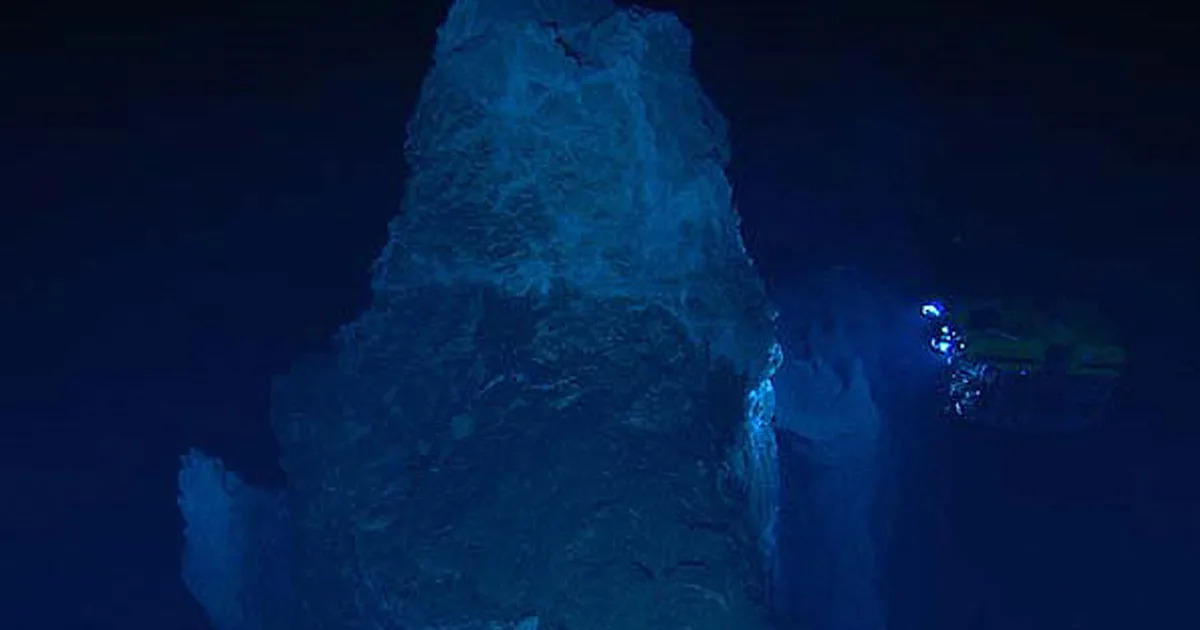Scientists Drill Super Deep Into Weird Underwater Structures
Frank Landymore
FUTURISM
Sat, 10 August 2024

Digging Deep
A team of researchers has recovered the deepest sample ever taken of the Earth's mantle from a section of seafloor in the Atlantic Ocean.
At more than three-quarters of a mile in continuous length, the cylindrical sample is also the largest of its kind. The drilling was carried out last year, but the findings have now been published as a study in the journal Science.
Researchers hope that the bevy of rare rocks within will reveal secrets about how the mantle facilitated underwater chemical interactions that may have given rise to life billions of years ago.
"We did it," study coauthor Frieder Klein, a member of the drilling expedition at the Woods Hole Oceanographic Institution in Massachusetts, told The New York Times. "We now have a treasure trove of rocks that will let us systematically study the processes that people believe are relevant to the emergence of life on the planet."
City of Secrets
The sample was extracted from an underwater hot spring called "Lost City," a field of spire-like hydrothermal vents that spew hydrogen and organic compounds like methane into water, making it an ideal site for the emergence of life.
Its location is key: the "City" sits alongside an underwater mountain range known as the Mid-Atlantic Ridge, which straddles the boundary between tectonic plates that are spreading apart. This process spews up molten magma that eventually cools to form mountains.
Scientists are interested in how mantle rocks could have created the chemical interactions that led to life, but recovering samples has proved challenging. They struck pay dirt this time, though, by drilling into a "tectonic window" in the seafloor where the mantle is much more exposed.
"When we recovered the rocks last year, it was a major achievement in the history of the Earth sciences," study lead author Johan Lissenberg from Cardiff University, said in a statement about the work. "But, more than that, its value is in what the cores of mantle rocks could tell us about the makeup and evolution of our planet."
Wearing the Mantle
Analyses of the rocks are ongoing, but so far they're already proving to be exactly the kind of time capsules of ancient geology that the researchers needed.
"The rocks that were present on early Earth bear a closer resemblance to those we retrieved during this expedition than the more common rocks that make up our continents today," said coauthor Susan Q Lang, an associate scientist in Geology and Geophysics at the Woods Hole Oceanographic Institution, in the statement.
"Analyzing them gives us a critical view into the chemical and physical environments that would have been present early in Earth's history," she added, "and that could have provided a consistent source of fuel and favorable conditions over geologically long timeframes to have hosted the earliest forms of life."
Sat, 10 August 2024

Digging Deep
A team of researchers has recovered the deepest sample ever taken of the Earth's mantle from a section of seafloor in the Atlantic Ocean.
At more than three-quarters of a mile in continuous length, the cylindrical sample is also the largest of its kind. The drilling was carried out last year, but the findings have now been published as a study in the journal Science.
Researchers hope that the bevy of rare rocks within will reveal secrets about how the mantle facilitated underwater chemical interactions that may have given rise to life billions of years ago.
"We did it," study coauthor Frieder Klein, a member of the drilling expedition at the Woods Hole Oceanographic Institution in Massachusetts, told The New York Times. "We now have a treasure trove of rocks that will let us systematically study the processes that people believe are relevant to the emergence of life on the planet."
City of Secrets
The sample was extracted from an underwater hot spring called "Lost City," a field of spire-like hydrothermal vents that spew hydrogen and organic compounds like methane into water, making it an ideal site for the emergence of life.
Its location is key: the "City" sits alongside an underwater mountain range known as the Mid-Atlantic Ridge, which straddles the boundary between tectonic plates that are spreading apart. This process spews up molten magma that eventually cools to form mountains.
Scientists are interested in how mantle rocks could have created the chemical interactions that led to life, but recovering samples has proved challenging. They struck pay dirt this time, though, by drilling into a "tectonic window" in the seafloor where the mantle is much more exposed.
"When we recovered the rocks last year, it was a major achievement in the history of the Earth sciences," study lead author Johan Lissenberg from Cardiff University, said in a statement about the work. "But, more than that, its value is in what the cores of mantle rocks could tell us about the makeup and evolution of our planet."
Wearing the Mantle
Analyses of the rocks are ongoing, but so far they're already proving to be exactly the kind of time capsules of ancient geology that the researchers needed.
"The rocks that were present on early Earth bear a closer resemblance to those we retrieved during this expedition than the more common rocks that make up our continents today," said coauthor Susan Q Lang, an associate scientist in Geology and Geophysics at the Woods Hole Oceanographic Institution, in the statement.
"Analyzing them gives us a critical view into the chemical and physical environments that would have been present early in Earth's history," she added, "and that could have provided a consistent source of fuel and favorable conditions over geologically long timeframes to have hosted the earliest forms of life."
No comments:
Post a Comment